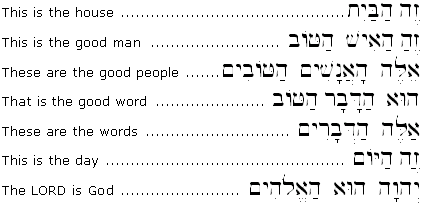|
Hebrew Demonstrative Pronouns
In English, a demonstrative pronoun functions as a substantival form of the demonstrative adjective, which you studied in Unit 5.7.
Demonstrative Pronoun Paradigm
The paradigm for the demonstrative pronoun is identical with the paradigm for the demonstrative adjective:

The first pair (this-these) stands for something near at hand, whereas the second pair (that-those) stands for something relatively distant or remote from the speaker. Here are some English examples:
This (one) is the man.
These (ones) are the kings.
That (one) the messenger.
Those (ones) are the saints.
Notice in these examples that the demonstratives are functioning substantively -- with an implied "one" (for singular forms) or "ones" (for plural forms).
Demonstrative Pronoun Properties
Demonstrative pronouns function just like predicate adjectives, and have the following properties:
- They appear before the noun they modify
- They agree with the noun they modify in:
- Gender (masc / fem)
- Number (sing / pl)
- but not in definiteness
Examples:


In these examples, notice how the demonstrative pronouns appear before their nouns with which they agree in gender, number -- but not in definiteness.
Other Examples:

Notice that a demonstrative pronoun appears before any other attributive adjectives that might modify the noun in an adjective phrase (for example, in the phrase zeh ha-ish hattov, the demonstrative pronoun appears before the entire adjective phrase).
Section Exercises
- Summarize the usage of the demonstrative pronoun on a small flashcard.
- Write some simple examples to help you remember the rules.
- From vocabulary you already know, create simple constructions using the demonstrative pronouns (example: This is the king.)
<< Return
|






